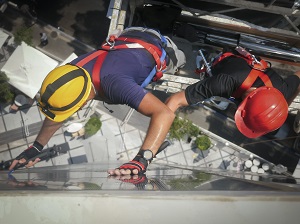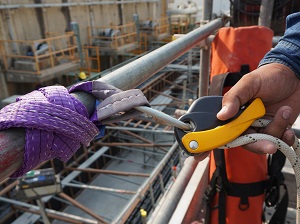Workers in all types of industries face potential fall hazards. Because fall incidents can often be deadly, they are a top concern for OSHA. Any organization that has personnel working at heights should have a fall rescue plan implemented.

Even when safety controls and fall prevention training are put into place by employers and practiced by workers, a fall incident may still occur. When workers are wearing personal fall arrest systems (PFAS) or protected using safety nets (or similar fall protection devices) a worker who has experienced a fall may need to be rescued.
OSHA General Industry Standard 1910.140(c)(21) The employer must provide for prompt rescue of each employee in the event of a fall.
OSHA Construction Standard 1926.502(d)(20) The employer shall provide for prompt rescue of employees in the event of a fall or shall assure that employees are able to rescue themselves.
Fall Rescue Procedure
A fall rescue plan is a procedure that provides details on how to safely retrieve a person who has fallen from an elevated work surface and is suspended in a full body harness, safety net or other fall protection device that has safely arrested the fall of the worker.
Types of Fall Rescues
The rescue plan may include assisted rescue, self-rescue and mechanically-aided rescue methods.

After a fall is arrested and a worker is in a suspended state, the rescue must be prompt, even if the worker may communicate that they are not injured. If a fallen worker remains suspended for too long, this can increase the severity of any injuries sustained or lead to other serious injury.
When a worker is using personal fall arrest system (PFAS) for fall protection, even if the PFAS is working properly, the worker’s body weight places pressure on the harness straps which can compress the veins and cause blood to pool in the lower extremities. This pressure prevents proper circulation to the worker's heart resulting in a potentially life-threatening condition called suspension trauma. If the pressure is not reduced quickly, the worker can lose consciousness within minutes. A prompt rescue can mean the difference between life and death.
When possible, workers using PFAS should be equipped with self-rescue equipment that allows the worker to lower themselves safely to the ground. Consider using a foot strap as part of the personal fall arrest system to aid fallen workers in alleviating pressure on legs after a fall when they are suspended.
OSHA General Industry Standard 1910.29(a)(2) and Construction Standard 1926.502(a)(2) Employers shall provide and install all fall protection systems … before that employee begins the work that necessitates the fall protection.

To provide for fallen worker rescue you may need a plan that details the procedures, equipment, and personnel needed to ensure that a rescue proceeds quickly and efficiently when a fall occurs. The rescue plan should also have procedures for different fall rescue situations. Workers who are protected by means of a safety net may not be able to exit the safety net on their own. A worker who is suspended from a lifeline who is unconscious may not able to perform a self-rescue and will need help from trained rescuers.
OSHA General Industry Standard 1910.30(a)(1) Before any employee is exposed to a fall hazard, the employer must provide training for each employee who uses personal fall protection systems…
What to Include in a Fall Rescue Plan
Consider the following to be included in the fall rescue plan:
- Accessibility available to complete the rescue
- Potential environmental and weather conditions
- Distance to, location of, and availability of local emergency services
- Communication method between rescuer(s) and fallen worker
- Rescue equipment required and location of equipment on site
- Training and skills requirements for rescuers
- Hazards that may be present during the rescue
- Structural features of work location
- Rescue methods that are available
- Rescue procedure(s) that will allow for safe and timely rescue

Emergency Services for a Fall Rescue
Ensure the local emergency authorities are identified in the rescue plan. It’s important to understand the fall rescue resources that are available from the local emergency services, if any, should a rescue need to happen.
In all cases where an employee falls and rescue procedures must be implemented, call 911 or the local emergency services number identified in the rescue plan.
If the fall rescue is for a person suspended in their PFAS, ensure that emergency responders are aware that treatment for suspension trauma may needed.
Do not rely on calling 911 as your only fall rescue plan. This could lead to a disastrous situation if local emergency service personnel are not trained or equipped to respond to the specific situation, or they are too far away to get to the work site quickly enough for a successful rescue.
Initially after a fall, especially a fall that is arrested by fall protection equipment, the rescued worker may appear to have suffered no injuries. It is important that any worker who has had a fall incident receive immediate medical attention because internal injuries may not be apparent but could be fatal if not treated properly by a medical professional.

Fall Rescue Employee Training
- All workers must be trained in fall hazard recognition and fall prevention.
- Review the current rescue plan regularly with all workers.
- It is imperative for competent and authorized workers to be prepared and understand the basics of fall rescue.
- Ensure rescuers are trained and can carry out an aided rescue, if required.
- All workers shall know their role in the rescue when a fall occurs.
- Mock rescues should be performed often enough to ensure competent workers are familiar with fall rescue basics.
- If a self-rescue cannot be performed safely, due to how or where the fall occurred, or if the worker is injured and unable to self-rescue, the competent worker on site must be prepared with a rescue plan.
OSHA Construction Standard 1926.32(f) "Competent person" means one who is capable of identifying existing and predictable hazards in the surroundings or working conditions which are unsanitary, hazardous, or dangerous to employees, and who has authorization to take prompt corrective measures to eliminate them.

.jpeg)

